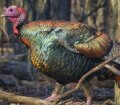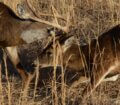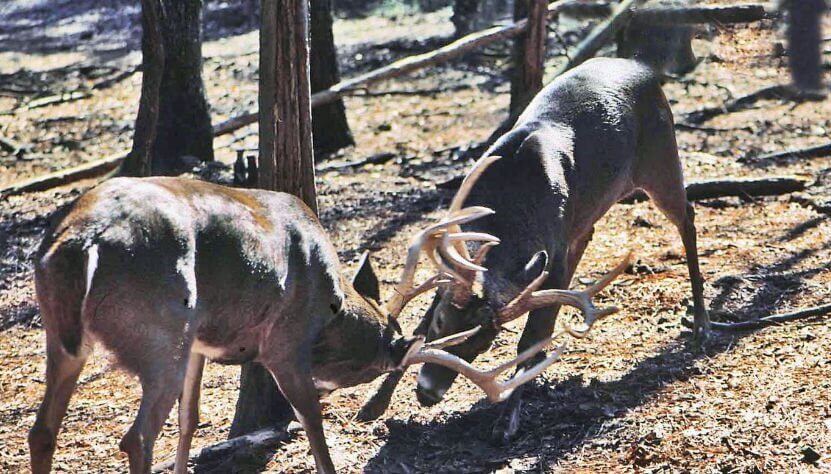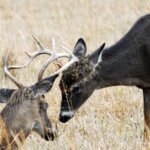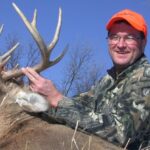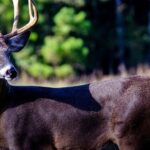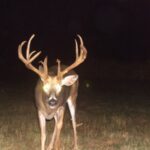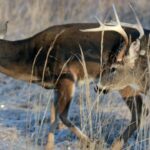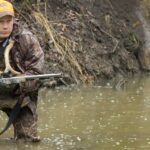Editor’s Note: Bucks fight for several reasons. When you hear antlers clashing, that doesn’t necessarily mean that bucks are fighting to the death. Instead, the bucks only may be pushing each other around. The more you know about buck fights, the better you’ll understand when to go and when to stay when you hear antlers clashing.
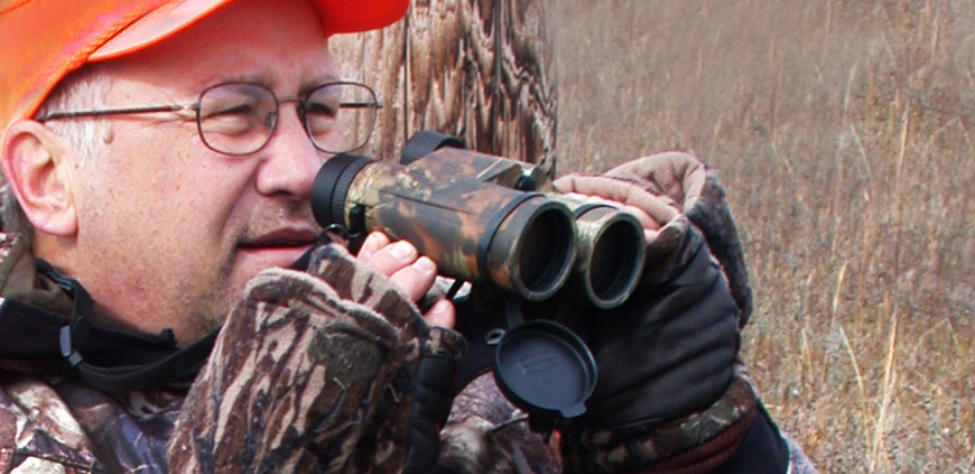
On my first hunt of deer season, I had spent the entire first day scouting for a place to hunt on the second day. I found a region where a clear-cut was divided from a hardwood creek bottom by a small, cleared firebreak. When I walked down the firebreak, I saw enough deer sign to convince me the deer were traveling back and forth from the clear-cut where they apparently were bedding in the hardwoods to where I assumed they were feeding.
Through the river bottom cane, I saw two bucks pushing and straining against each other. Their antlers clattered as they shoved each other to establish dominance. Two spikes and three does stood back and watched the drama being played out.
I couldn’t clearly see, even with my rifle scope, which fighting buck was bigger. But as quickly as the fight had begun, the hostilities stopped. The herd of deer trotted back into the dense, three-year-old clear-cut from where they had come, before I could get off a shot.
The next morning before daylight, I walked into the area where I had decided to take a stand. Just before the sun came up, I spotted a deer about 80-yards from my stand. Using my binoculars, I realized the deer was a doe.
A White-Tailed Deer Parade and Fight:
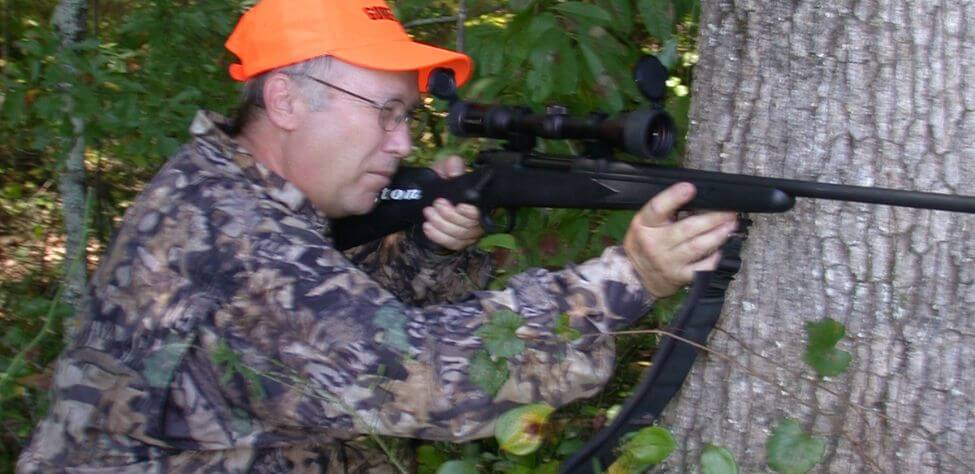
As I watched, a whitetail parade began. After the first doe, two more does crossed the firebreak. Then a spiked buck with a flattened or palmated left antler appeared, as did a second spike with antlers about 5 inches above the hairline. A wide-racked buck darted across the opening – followed by a second, well-antlered buck. After the two large bucks fought, and I failed to get off a shot, the deer left the area.
Sitting in the cool morning air, I decided if I didn’t see another deer all day, I’d still had had a very-profitable hunt – watching the four bucks and seeing the two larger deer fight. But within five minutes of having seen the deer, I looked back down the firebreak. As I watched, the flat-horned spike, followed by the rest of the bucks and does went by on parade again. They’d followed the same course they’d taken earlier in the morning and moved into the cane along the creek bottom. However, I didn’t take a shot because I still was unsure how many points the two biggest bucks had. Where I was hunting, hunters only could harvest 8-point-or-better bucks. I didn’t want to make a mistake.
The deer moved down the bank of the creek just on the other side of the cane from me. As the deer came closer, about 40 yards from my stand, the flat-horned spike stepped out first. He was cautious as he moved out into the hardwoods and began to feed on acorns. The three does were behind him, and the second spike followed the does.
I had my rifle on my knee looking at the deer through my scope when I saw a well-racked buck step into the clearing. Before I made the decision to take the shot, a second, even bigger, buck came out of the cane. As I evaluated the racks of the two large bucks, I saw they were both nice 8 points. I made the decision to take the larger deer.
Another Deer Fight:
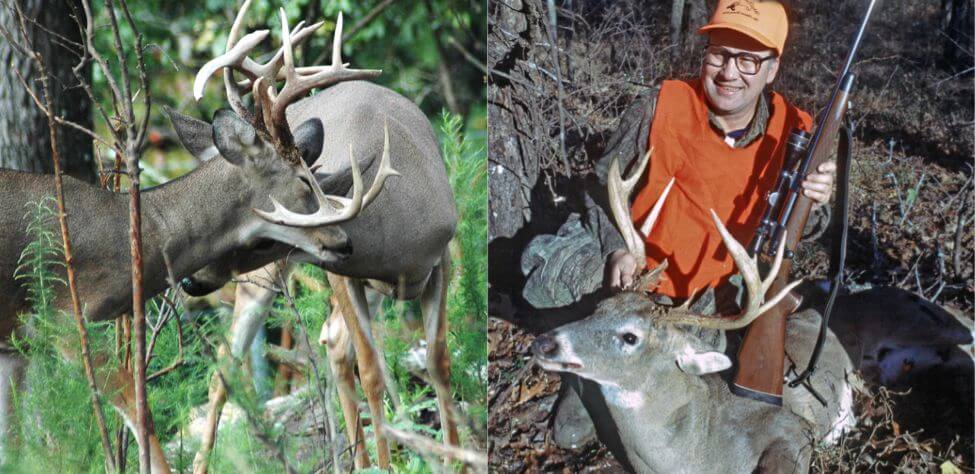
However, before I could get off the shot, the two bigger bucks locked antlers and began to push and shove each other across the clearing. While I watched the fight through my scope, finally the biggest buck pushed the smaller buck’s nose down to the ground and held him there, until the crosshairs in my scope came to rest on the biggest deer’s neck. I touched the trigger of my .30/06 – bringing the fight to a deadly end.
The smaller buck jumped up quickly after I’d downed his larger rival. I bolted the gun hastily and brought the crosshairs to rest on the second 8 point’s shoulder. As the smaller buck looked at his fallen rival, I said to myself, “You’re presenting a good shot.”
Next, I moved the crosshairs to the neck of the flat-horned spike and announced, “I could take you, but not today.” Then I took deadly aim on the remaining spike and knew that I also could have bagged him. I lowered my rifle without ever firing another shot and watched as the bucks and the does walked back into the cane and across the firebreak and returned to the clear-cut.
In one morning, I had seen two buck fights, bagged a nice 8 pointer and could have shot at three more bucks, if the season and bag limits had permitted. This day was one of the most memorable I ever spent in the woods. That day’s happenings also triggered my quest for knowledge about why bucks fight.
I learned that bucks fight generally at two different periods of the year, during the prerut, which is before the breeding season, and in the rut, which is the breeding season. My quest for knowledge took me to some of the nation’s leading scientists and hunters.
Tomorrow: Prerut Deer Fights

How to Hunt and Take Big Buck Deer on Small Properties
In this book, you’ll hear from 14 hunters who either have gained permission or leased properties as small as six acres to as much as 250 acres, and how they consistently take older-age-class bucks off these little lands.
VERSIONS: AUDIBLE, KINDLE & PRINT

Jim Crumley’s Secrets of Bowhunting Deer
Using a black magic marker and a gray work jumpsuit, Jim Crumley of Buchanan, Virginia, drastically changed the nature and purpose of hunting camouflage when he created the first sportsman’s camouflage – Trebark. Crumley’s love of bowhunting and his desire to be more invisible changed hunting clothing forever.
In this hunting guide, he shares the wisdom that he’s learned throughout his lifetime about how to be a hunter, how to find a deer lease, how to scout for deer, and more.
Special features include how to:
- Have a magic 60 acres to hunt
- Decide the best equipment to use
- Find deer year-round
- Locate land to hunt
- Know the best place to put your tree stand
- Get bucks within bow range
VERSIONS: AUDIBLE, KINDLE & PRINT

How to Hunt Deer Like a Pro
How do you know if the land you hunt has a trophy deer on it? Wildlife manager Bob Zaiglin, of Uvalde, Texas and Jim Crumley, the father of modern-day hunting camouflage, tells you how to find out. GPS can make finding and taking that trophy buck easier. This hunting guide will teach you how to hunt big bucks where no one else can find them, how to call deer, and how to become versatile as a deer hunter, so that if one deer tactic doesn’t work, another one will.
In the chapter, “How to find Bucks at Scrape,” Dr. Keith Causey, retired professor of Wildlife Science at Auburn University, describes the best way to hunt a scrape.
Brad Harrison of Neosho, Missouri, is a nationally-known videographer, professional deer hunter and master at calling deer. Another master is Will Primos of Primos Game Calls. These two experts will tell the best deer calls and when to use them in this book.
And for over 20 years, Bo Pitman, lodge manager of White Oak Plantation, has been studying deer movement patterns. He explains what types of conditions are best for predicting deer movement.
VERSIONS: AUDIBLE, KINDLE & PRINT

Deer hunting and deer hunters are drastically changing each year. To learn new techniques for hunting deer and have more places to hunt, I’ve interviewed some of the best deer hunters in the nation and share their tactics in How to Hunt Deer Like a Pro: Volume II.
In Chapter 10, Jacob Lamar tells you his tactics for consistently taking older-age-class bucks on public lands in several states. Chapter 11, Bob Walker explains how to find places on public lands where you can hunt that 99 percent of the other hunters never have considered hunting. The Bonus Chapter with David Ramey tells you how, where, when and with what equipment to take big Kansas bucks on public lands by hunting in 100-degree weather when others won’t hunt.
Chapter 13, Mark Drury, his family and his guests take mature bucks every season by having more small places to hunt rather than one large property. Drury explains the strategy of having satellite farms to hunt that only may be 50-150 acres each or less. Chapter 15, Pat Reeve, who hunts far-northern states and Canada, says, “I don’t like hunting for mature bucks until the weather is 20 degrees or less.” Chapter 4, Dr. Larry Marchinton says that funnels are the most-reliable stand sites to hunt for big bucks and tells why.
VERSIONS: AUDIBLE & PRINT

